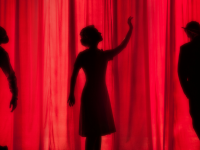To write larps and invite people to take part in your story is to be a leader.
It’s a responsibility and a privilege to make people part of your vision. It requires a flexible mindset and a good understanding of how to make people engage to make people feel included and safe enough to open up to real collaboration. As a larper you have the opportunity to use the strengths you’ve learned in this amazing community in your role as a leader.
A lot of what I do in my professional role I’ve learned in the larp community. I’ve worked with building and leading teams towards a common vision for almost 15 years and been a part of the larp community, as a participant and creator, for a good part of three decades. It’s interesting to distill what I’ve learned in the community and how I can use that as an organizer or leader in other contexts.
So, what is it that we do so well? I’m gonna tell you the big secret right away: It’s about making collaboration possible by creating the prerequisites for successful human interactions.
For me, the key to any great creative outcome, no matter if it’s a larp or a new software feature, is people collaborating towards a common goal. To get people to invest their time, effort and feelings in a project isn’t easy, but it’s the most powerful tool in making awesome stuff. Larping is in itself built on the mechanics of engagement. When I’ve drilled down on that idea, I have found three key things about how we do it in the larp community that you can use with intent to make successful interaction and collaboration possible in any context.
- Build your magic circle to help people engage and collaborate.
- Be transparent and help people feel safe with where you’re going.
- Help people lift each other and play to each other’s strengths.
When you use these keys you have the possibility to build something unique and very powerful. In a team we might call it flow, in a larp it might be that elusive thing we call larp magic.
Help People Engage – Build Your Magic Circle
The more people there are who care about a project, the better. It will make your life, and the execution of your vision, easier if the people around you care as much as you do. Build a community around your idea; build your magic circle.
The idea of magic circles comes from play theory and basically means to create the framework in which we can collaborate, to build an arena in which we meet on the same terms.
The magic circle is created by a set of rules and to be able to participate you have to agree to those rules. Larps in themselves are magic circles and the rules guide the setting we’re in and how that fictional world works. Putting people together in a group doesn’t make a magic circle by itself. You create the magic circle by getting the people invested in the group, co-creating what is important, how they interact and what makes this particular group a “we.” Both the rules guiding how we interact and work together, and the small, unofficial things that make us feel like a unique unit, are part of that “we.”
Large magic circles must have more clearly stated rules, vision and strategy to function well. A larp has a setting and rules that govern its world. Done right, an organization might work as a large magic circle. In those large circles there is the possibility of a multitude of smaller circles, and you can be part of several magic circles at the same time. To keep a magic circle alive over time you have to put routines in place that work as a reminder of the rules and why this group of people has a common purpose.

Build And Maintain Your Magic Circle
- Work together on the vision and the guiding star of your project. Look at the vision from different angles and try the idea from different perspectives. This will allow the team to get to know, shape, and feel invested in the vision and make it part of your magic circle.
- Run a workshop (or several) to create consensus in the team about what’s important to make your collaboration work. Look at formal rules that you want to follow, like the way you want to check in, communicate and share progress. If you have worked together for a while you might also make a map of the things that bind you together, the unspoken things that create a “we” out of the group.
- Continuously revisit the conditions of your circle. Schedule time to look at your rules and ask yourself “are we living by this?” If not, what do we have to change to make it work better?
- Talk about how you foster security in the team. For example, how do you handle mistakes and failures? How does the group pick up and help each other forward? Make this part of the rules in your circle.
- Have fun together! The best projects are created by people having fun doing it.
Help People Feel Safe – Transparency
For people to be able to step into and co-own a project or product, they have to feel secure with where we’re going. Uncertainty is the death of collaboration. The best way to help people care about a vision, and feel safe with it, is to invite them in to share the vision with you.
In the larp community we talk about levels of transparency, and people have different preferences. To be able to collaborate you have to know that you share an understanding of what you are doing. That you are aiming at the same goal. Otherwise the risk is high that you will be going in different directions.
In a larp context this might entail having a super clear dramaturgical curve where everyone knows how the ending will be. From a player perspective, a high level of transparency is important even in the least transparent larp designs. In every scene you have to show your intent, where you are going and why, to make it possible for your co-larpers to buy into your idea and help you play it out.
Things That Help Us Be Transparent
- Impact maps – work together with your team to define the goal, the impact you’re looking for and how you get there.
- Visualization – keep eyes on the prize by having the vision and goal in plain sight. Write it on a wall, name your chat with your vision or print it on t-shirts!
- As a leader, be open with decisions that affect the team and the team’s work.
- Make space for people to talk about fears, obstacles and difficulties and how we can address them to make positive change.
Help People Be Awesome – Play To Lift
To succeed with collaboration, during a scene or when building something cool together, help each other be as awesome as possible. Focus on the common achievement instead of the individual.
Play to Lift is a common concept in the larp world, but do it in your everyday life and you might reach unexpected heights!
Interaction and co-creation is about giving and taking. It is about giving space and making space for each other’s skills and roles and helping each other to succeed as well as possible. There is something un-dramatizing in focusing on lifting others instead of focusing on oneself. It becomes not about my own achievement but about helping my co-players or teammates shine. So, play to lift works both as a way to relax and let go of your own performance anxiety, and to work together to find and highlight the most interesting and important aspects in the roles played or the project you create.
How We Play To Lift
- Give space to the expert and ask others for insights, knowledge and participation.
- Work with teams with different competencies and make the most of that by inviting different competencies into all parts of the process.
- Make it a part of your routine to acknowledge each other’s work, input and achievements.
- A method is only as good as how it works for the people using it. Make sure your methods are useful by choosing them with care, focusing on the outcome you want. Adapt the method to your needs.
- Evaluate your process continuously – ask yourself what went well and what we can improve.
- Ask for help! Use others’ awesomeness when you’re stuck.

The Goal
So what’s the end goal?
The most immediate answer is co-ownership, not only for the creative outcome and experience but also in terms of responsibility. When people feel responsibility for the outcome they tend to make an effort to make things move along and pitch in when things go south instead of sitting back and complaining.
The second benefit is engagement. Helping people go from passive on-lookers to active participants, nudging them to help create momentum instead of waiting for someone else to start something.
And third, a common feeling of wanting the best for each other. A friendly environment where it’s okay to mess up because your friends will pick you up and help you along and you will do the same for them.
To lead is both to invite collaboration and to give a clear direction. Using these techniques that you know from larp to help people care, engage and lift each other helps you do just that. And as an extra plus, your vision will probably turn out even more awesome than you imagined!
Cover image: Image by stevenunderhill on Pixabay. Image has been cropped.
This article is published in the Knutpunkt 2022 magazine Distance of Touch and is published here with permission. Please cite this text as:
Rönnåsen, Moa. 2022. “Leading with Larp Magic.” In Distance of Touch: The Knutpunkt 2022 Magazine, edited by Juhana Pettersson, 100-104. Knutpunkt 2022 and Pohjoismaisen roolipelaamisen seura.







